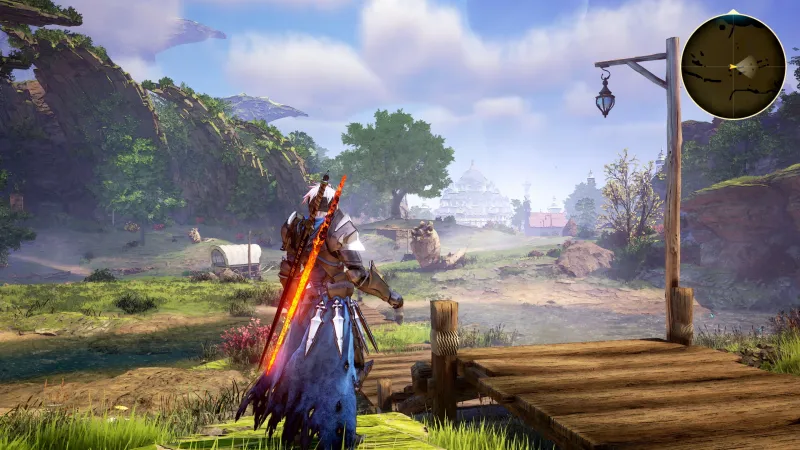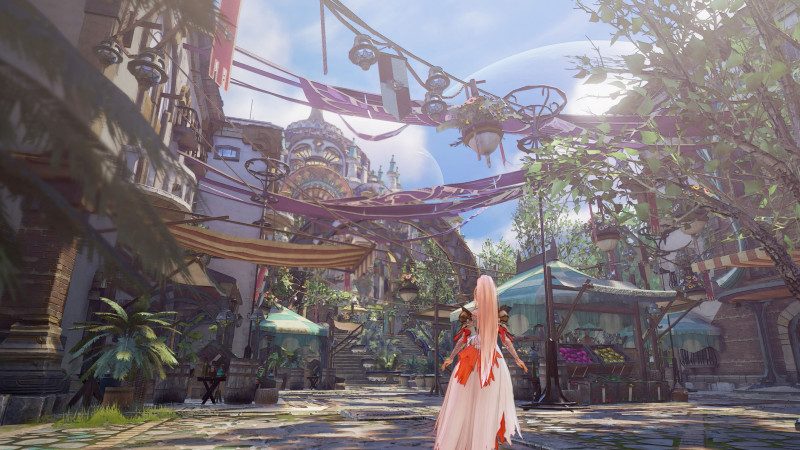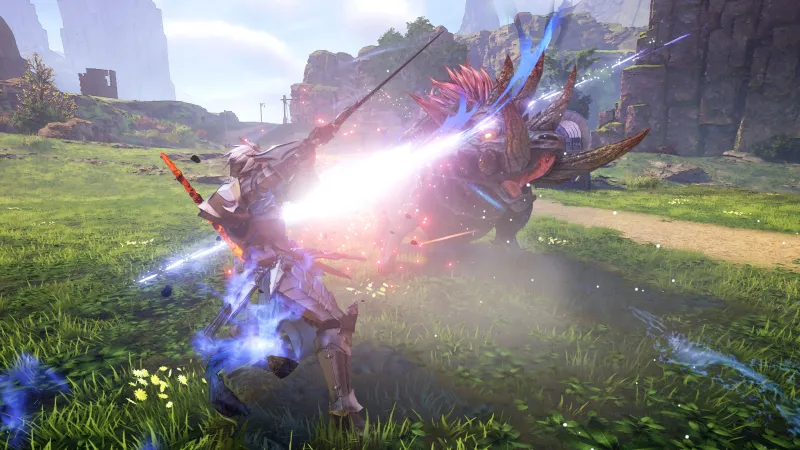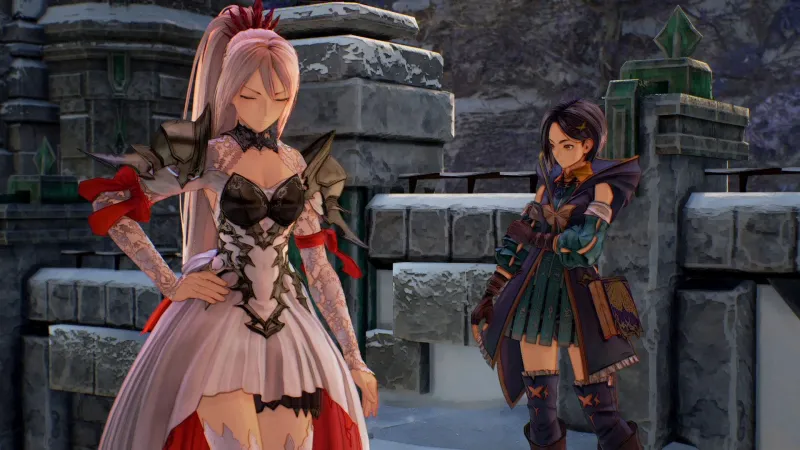
I’ve been a longtime fan of the Tales series; whether it was watching Symphonia’s Llyod confront his naivety or seeing Abyss’ Luke realize he’s kind of a jerk, I love how the main characters become better versions of themselves through the bonds they build. While Tales’ strongest features are its character interactions and the fast and fun action combat, it’s struggled this last generation to both appeal to modern gamers and provide something new and exciting for its longtime fans.
Tales of Arise is being called a “reinvention” for the venerable, if stuck-in-a-rut, franchise. Any time a long-established series uses the word “reinvention,” it’s hard not to be skeptical. Change is scary and risky, as developers try to toe the line between retaining the elements that fans cherish while also evolving the formula in different and interesting ways. I wasn’t sure what side Tales of Arise would land on, but after going hands-on with the game, I feel much more confident in Bandai Namco’s new vision for the series due to some smart tweaks to combat and a new interesting world that begs to be explored. Here are some of my big takeaways.

A Vast World With Cool Discoveries
The hands-on demo didn’t offer much in terms of story or character personalities, outside of allowing us to see protagonists Alphen and Shionne bickering. The demo did, however, highlight part of the game’s third region called Elde Menancia, which looked more rural, focusing on nature’s beauty with forests, streams, and even a hidden waterfall for good measure. The demo took place about 10-20 hours into the main story, when you finally have all your party members.
What stuck out about the world to me – outside of the breathtaking watercolor-like aesthetics – was just how much is hidden off the beaten path to discover. From items such as ores for crafting to ingredients for recipes, there always seemed to be a reward for taking the time to explore. This includes stumbling upon special treasure chests, where I found valuable materials, such as accessories and better weapons. At one point, I came across a small farm with cows, pigs, and horses grazing, and of course, the cows provide milk to use in cooking recipes. Yes, cooking is back. Bandai Namco said it will talk about this feature more at a later date, but so far it looks like what we’ve come to expect from these types of systems, offering stat boosts in battle, like giving you more attack power for a certain duration.
Alternate paths are all around if you seek them out. Later, I found a hidden stream, which had a waterfall with a small cave housing a valuable chest. I played the demo three times, and each time I found a new discovery, whether it was a hidden area or treasure to unearth. It appears that Bandai Namco is packing a lot into the zones, so they don’t feel like big, empty spaces like in previous games. Tales of Arise isn’t open world, but it certainly feels grander than any other Tales game.

The Fluid Action Combat Still Shines
A strength of the series has always been its fast and fluid action combat that’s focused on chaining up combos and pulling off flashy moves. That isn’t changing; the action is still fast-paced and combo-driven, where you swap between regular attacks and your artes (special moves that cost points to use). You can string up to three normal attacks together, but this limit can be increased once you learn certain skills. Jumping and attacking in the air also causes characters to unleash different normal attacks, which is a nice touch and adds some variety to how you play and what moves you want to chain together.
The controls are a little different than previous games and it did take me a few battles to acclimate to them. Your regular attacks are executed using the right bumper, while all your artes are on the face buttons. The right trigger acts as your defend/evade. If you time your evade/guard just right, you perform a perfect evasion/guard, nullifying any damage and giving you the opportunity to counterattack by pressing attack.
You have two things to keep track of as you fight: AP (artes points) and CP (cure points). The former is all your special, damage-inducing attacks, while the latter is your support and healing artes. New to this entry is boost strikes –potent, one-hit kill co-op attacks – that can be executed once you fill a gauge up through combat. These are more likely to occur at low enemy HP and higher combo counts. In addition, every character also has their own unique boost attack, which you can use in battle with the d-pad. Filling up a boost gauge, which charges over time and by landing attacks and counters on enemies, enables you to activate these.
I was impressed with how smooth the controls felt, the variety of attacks at my disposal, and the satisfaction that comes from delivering those satisfying cinematic special moves. The battlefield remains chaotic, which means it can also be hard to keep track of where everyone is when the action heats up. Four total party members can be on the field at once, with two others in the support spots. At any given time, you control one character, but can swap to others in an instant. You can also play around with the party tactics, which allows you to focus your members on attacking, healing, or taking the default, balanced approach.

Different Character Playstyles Make Battles Feel Exciting
Party members all have something different to offer in terms of their playstyles, and each one has their own special perk and boost attack. I played the demo multiple times using various party members, and my strategy shuffled depending on who I controlled, offering a new and exciting feeling to how battles played out.
I started with knight Kisara, who wields a giant hammer and has a huge shield to match it. With her strong offensive and defensive capabilities, she’s perfect to fight on the front lines, but with big weapons and armor comes slower attacks and movement. Thankfully, Kisara’s perk is Guard Ignition, which means she uses her shield to block attacks instead of dodging them outright. She can even trigger some artes while guarding. If you successfully block with her shield, it raises her morale, making any artes and combos unleashed during this time stronger and harder to block.
Kisara is a more advanced character to learn; she’s powerful but you need to use her abilities wisely to get the most out of her. For instance, her massive shield can also protect others, but that requires paying attention to your party members and the enemy in front of you. Like I said earlier, battles play out fast and chaotically, so this isn’t exactly always easy. It took me some time to find my rhythm with her, but she’s fierce and her boost attack can be a big blessing, as it downs any enemies it hits, weakens their charge attacks, and boosts all allies’ defense, both physically and elementally.
